How To Clean And Deodorize A Garbage Disposal
15 Things You Should Never Put Down a Garbage Disposal
The modern garbage disposal provides a quick and sanitary way to dispose of food waste, keeping trash bags lighter and landfills from overflowing. But even this venerable appliance can choke on certain items.
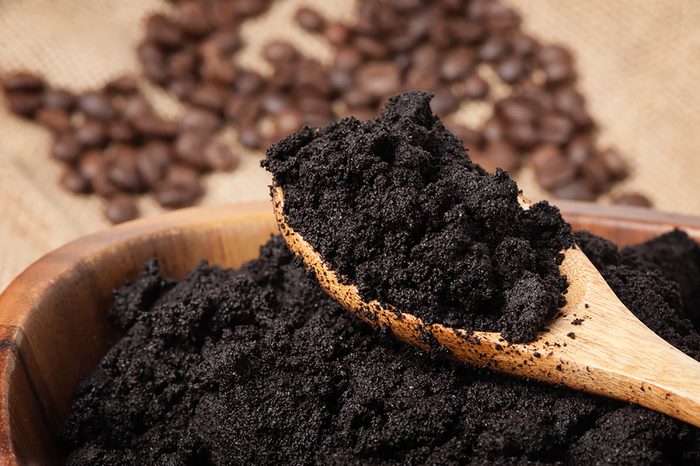 Nor Gal/Shutterstock
Nor Gal/Shutterstock
Coffee grounds
Let's start by debunking a common folk remedy. While it's true that dropping coffee grounds into your garbage disposal reduces odors in the short term, it can actually cause more serious problems down the drain. To understand why, think about what used coffee grounds look like when taken out of a filter: They reduce into a dense, thickly packed pasty wad. And that is exactly what you don't want going in your drain lines! You should never, ever pour these 12 things down the drain, either.
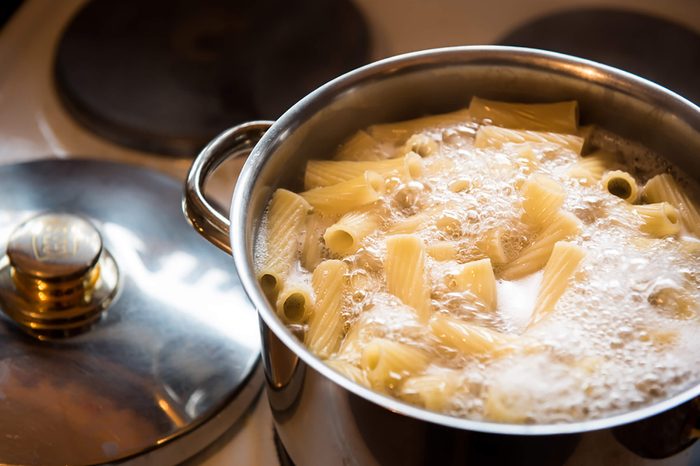 Ivana P. Nikolic/Shutterstock
Ivana P. Nikolic/Shutterstock
Pasta
Anyone who's made spaghetti or mac & cheese knows that pasta expands when soaked in water. Given that, you can see why you might not want to drop lots of pasta into your disposal and drain where it will, after all, soak in water and keep expanding. Like most of the items on this list, a few scraps cleaned off of a plate won't hurt. But don't try to dispose of an entire pasta casserole, and when you do run pasta through the disposal, run the water as cold as it will go for 30 seconds afterward, to flush it through the trap and into the mainline.
 gowithstock/Shutterstock
gowithstock/Shutterstock
Bones
Garbage disposals are wonderful at grinding up and disposing of food waste. But just because they can grind doesn't mean they're made to deal with extremely hard items, such as bones. If you do drop a chicken wing or fish bone in the disposal, don't panic. Disposals are hardy appliances and can handle grinding up the occasional small bone. But if you try to drop a rack of ribs down your sink and grind them up, you're setting yourself up for disaster. Watch out for these other kitchen mistakes it's time to stop making, too.
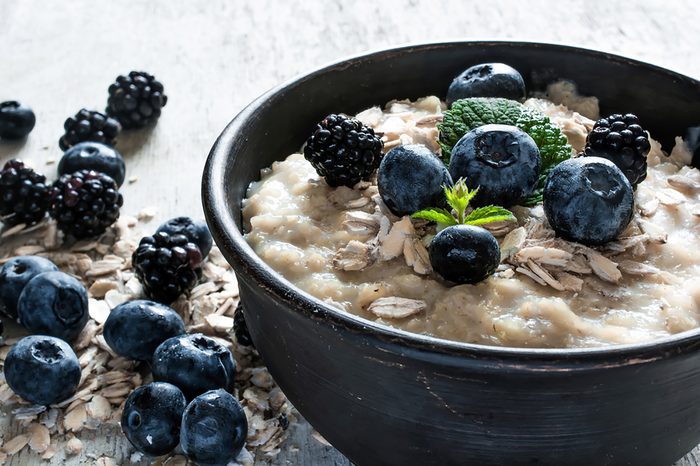 artem evdokimov/Shutterstock
artem evdokimov/Shutterstock
Oatmeal
Much like pasta, oatmeal is another expansion threat. Uncooked oats, in particular, are likely to slip through the disposal untouched, only to collect and expand down-line. If you're lucky, they'll eventually flow out to the sewer.
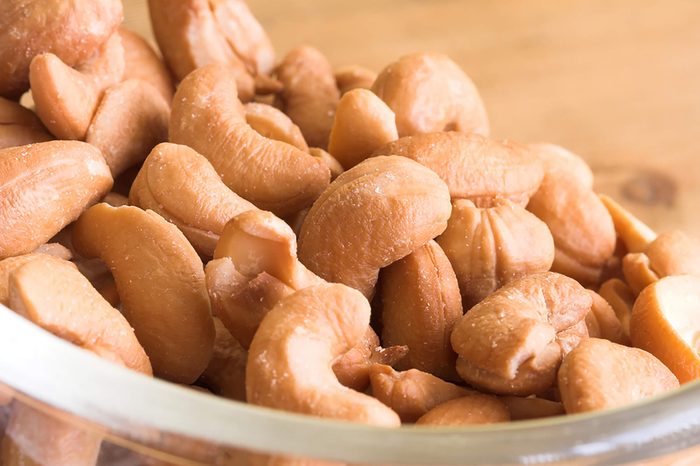 Simone van den Berg/shutterstock
Simone van den Berg/shutterstock
Nuts
If you ever find yourself about to dump several handfuls of peanuts down your garbage disposal, take a moment to consider how peanut butter is made: Handfuls of peanuts are dumped into a grinder, where they're spun and mashed into a sticky, thick paste. And your garbage disposal is an excellent appliance-sized version of a nut grinder. Limit the number of peanuts (and other varieties of nuts) that drop into the disposal and you'll be far better off. Avoid these ways that you're cleaning your kitchen wrong.
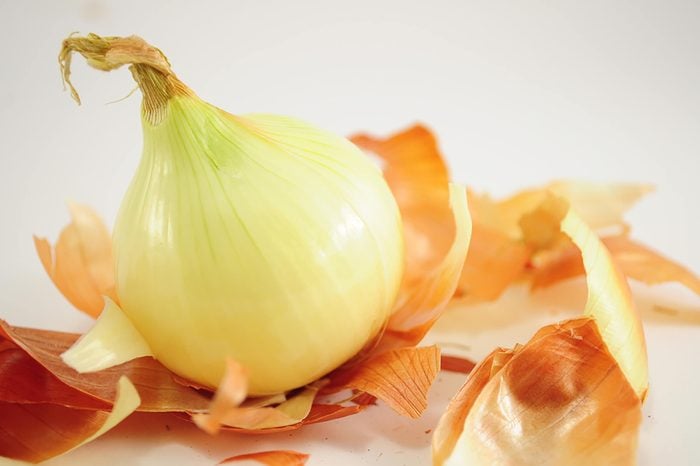 andria01/shutterstock
andria01/shutterstock
Onion skins
Chopped, diced, or in chunks, most onion waste shouldn't be a problem for your disposal. The problem comes with the thin membrane that lies just below the dry, outer-most layer of an onion. That thin, wet layer is often removed before the onion is chopped, and thrown into the disposal. But the layer is so thin that it can pass through the disposal, missing the blades and wind up wedged in the drain, where it catches more items and holds them in place. Luckily, it's fairly simple to avoid this problem. Just drop the thinnest outer layer in the trash, or cut it up before dropping it in the disposal. It's a few seconds of work that can save you hours of work or an expensive visit from a plumber.
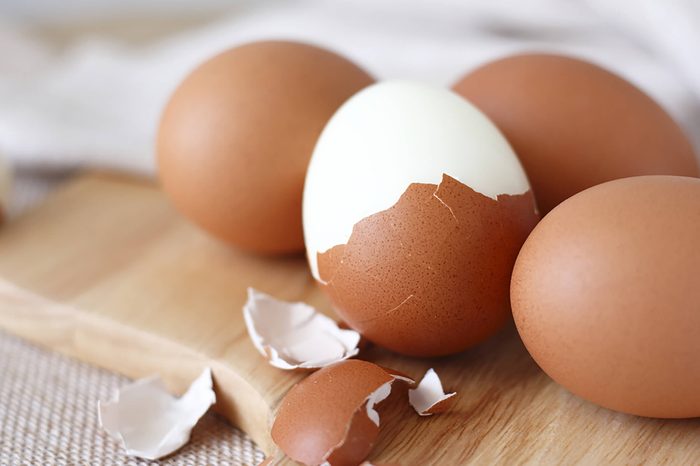 meaofoto/Shutterstock
meaofoto/Shutterstock
Egg shells
You may have heard that it's a good idea to drop egg shells into the garbage disposal. The idea is that the shells somehow sharpen the blades mounted on the disposal wall. It's hard to say where this theory got started, but if you stop to think about it, when was the last time you've seen anyone sharpening knives and lawnmower blades with a carton of eggs? While eggs don't do much to help your disposal blades, at least the shells themselves don't do any damage. However, the next time you crack an egg, take a close look at the shell. You'll see a thin membrane on the inside of the shell that can (like that thin membrane of an onion) get loose and lodge in the drain or around the impeller (the rotor that throws waste against the wall-mounted blades).
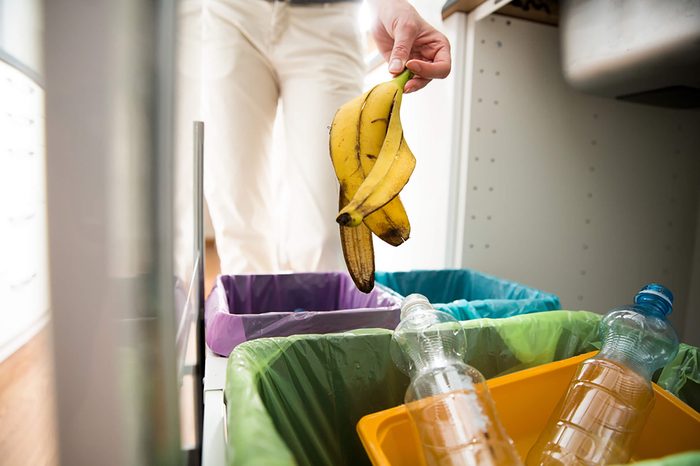 Aleksandra Suzi/Shutterstock
Aleksandra Suzi/Shutterstock
Trash
OK, speaking of trash, it's worth saying this officially: We know it's called a "garbage" disposal. That doesn't mean that you should put all your garbage in it. Talk to a plumber or handyman, and you'd be shocked by how many times they need to dig out paper towels, bags, candy wrappers and banana peels that definitely don't belong in the disposal. Find out some more things your plumber really wishes you knew.
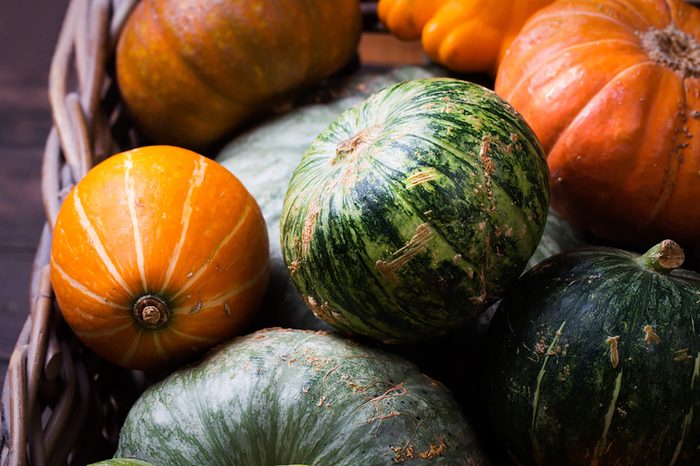 oxyzay/Shutterstock
oxyzay/Shutterstock
Pumpkin and fibrous vegetables
If you've ever scooped out a pumpkin for Halloween, you know how the long strands can get caught on your hand and scooper, turning the whole situation into a sticky mess. Avoid transferring that mess into your disposal by disposing of pumpkin guts in the trash. The same goes for veggies like celery and rhubarb. Throw long, stringy stalks straight in the trash to keep the fibers from causing a problem, but don't worry about small pieces. When chopped up, the fibers are small enough to not cause a problem.
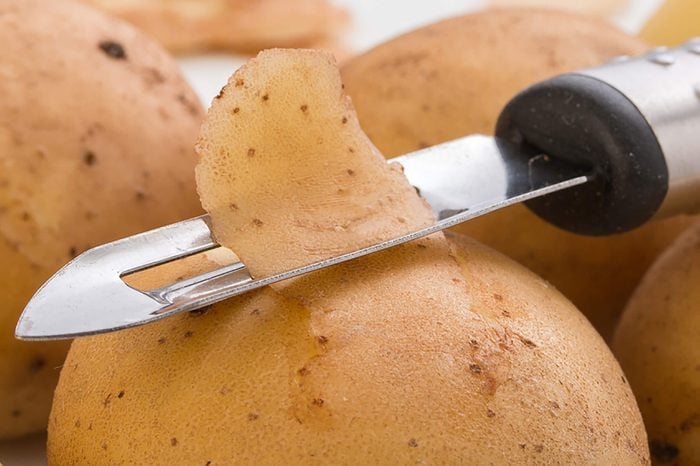 little birdie/Shutterstock
little birdie/Shutterstock
Potato peels
Potato peels are thin enough to slip past the disposal, potentially catching in the drain. There they can cause the same issue as the egg membrane, acting like a tiny catcher's mitt, holding up other waste and creating a clog. Again, a few peel pieces are nothing to worry about, but many recipes call for several potatoes, and the stack of peels quickly adds up. Learn the foods you should never keep in the freezer, too.
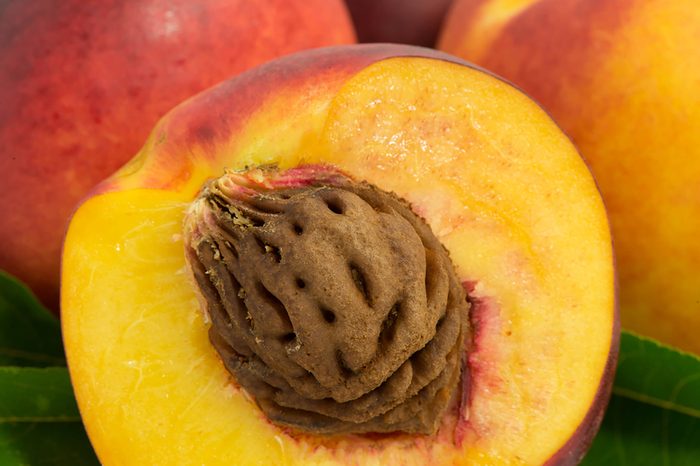 Leonid S. Shtandel/Shutterstock
Leonid S. Shtandel/Shutterstock
Pits
Peaches are delicious, and avocados inspired an entire generation of kitchen color schemes, but they both have incredibly hard, dense pits in their center. As a good rule of thumb, if you can't chop it with a knife, it's not going to grind up in the disposal. (Actually, it might once or twice, but it won't be long before you're taking a trip to buy a new disposal.) If you do make a habit of dropping too-hard items in the disposal, it normally won't kill the motor, but you'll end up with a machine that isn't disposing of waste properly. Eventually, you'll just grow frustrated with it and end up replacing the unit. Should it come to that, follow these tips for the best way to replace a garbage disposal.
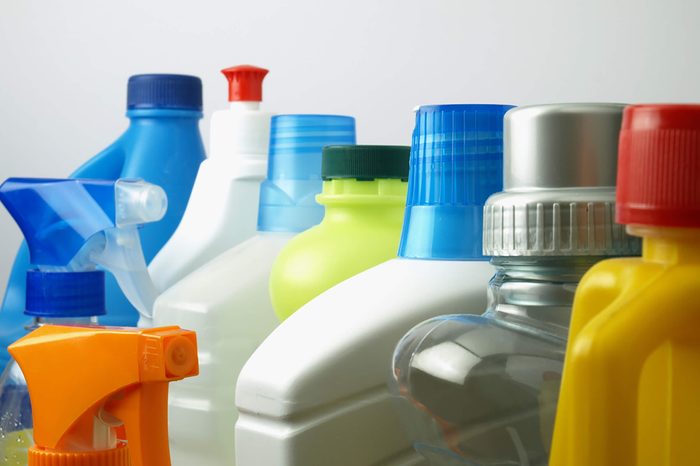 alejandro dans neergaard/Shutterstock
alejandro dans neergaard/Shutterstock
Cleaning chemicals
We're not talking about dish soap or normal cleaners. Those are fine for normal use. The chemicals to avoid are harsh drain busters and industrial-grade cleaners. They can put excessive wear on your disposal and possibly even the drain line. Instead, use ice cubes to clean off the blades, and a little dish soap to deodorize and break up any grease build-ups.
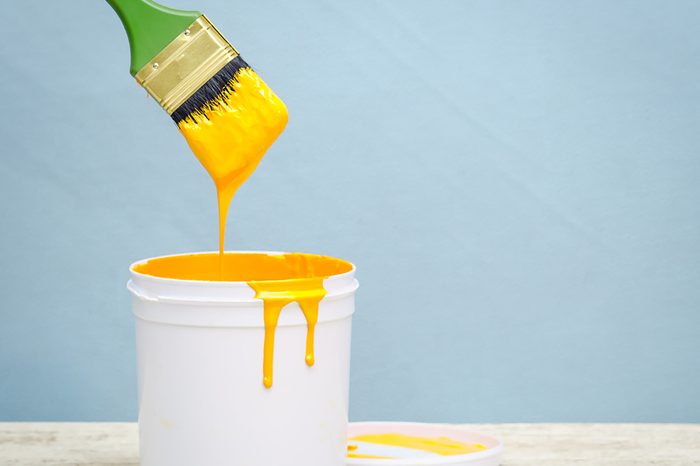 showcake/Shutterstock
showcake/Shutterstock
Paint
This is one mistake that DIYers are especially prone to committing. Latex or oil paint should never be poured straight down the drain. It can cling to the side of the disposal or sit in pipes, where it will begin to cure and harden into an intractable clog. Again, a little paint heavily diluted won't be an issue as long as it's heavilydiluted. But brushes and rollers should be cleaned with some forethought, using an appropriate container, while bulk paint should be disposed of appropriately. Find out the things that should never, ever go in your dishwasher, too.
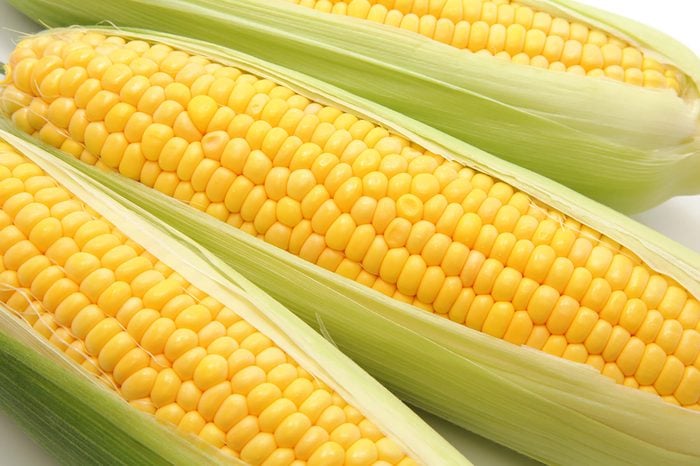 haru/Shutterstock
haru/Shutterstock
Corn husks
Husking corn creates a tremendous amount of waste, and as much as possible should go in the compost pile or trash, rather than the garbage disposal. The robust, fibrous husk and fine threads of corn silk create a dual threat for disposals. So whether your corn is store-bought or homegrown in a garden, it's a good idea to husk straight into a bag, and not let it near the disposal at all.
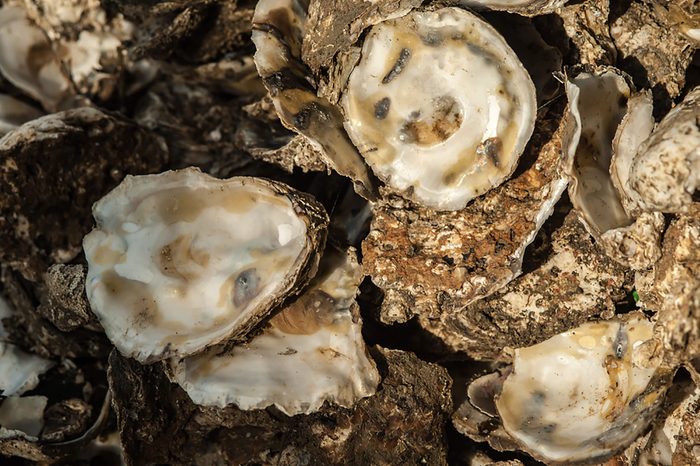 somsak suwanput/Shutterstock
somsak suwanput/Shutterstock
Shells
Hard shells from seafood such as crab, lobster, shrimp, and oysters are a common garbage disposal problem. Many of these shells are far too dense to grind up properly, while the ones that might slip through (like shrimp) have a chance to catch in the drain. So skip the disposal and drop the shells in the trash, preferably a small trash bag so that you can take it out of the kitchen immediately. Next, find out some food parts you've always thrown away—but shouldn't be.
Originally Published: January 31, 2019
![]()
Sign up for articles sent right to your inbox
Enjoy the best stories, advice & jokes delivered right to your inbox!

Subscribe & SAVE Save Up To 84%!
How To Clean And Deodorize A Garbage Disposal
Source: https://www.rd.com/list/never-put-down-garbage-disposal/
Posted by: ishmaelnowerever98.blogspot.com

0 Response to "How To Clean And Deodorize A Garbage Disposal"
Post a Comment